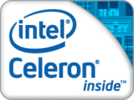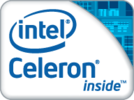Intel Celeron 2961Y vs Intel Celeron 2950M
Intel Celeron 2961Y
► remove from comparison
The Intel Celeron 2961Y is an entry-level, ULV (ultra low voltage) dual-core processor for subnotebooks and tablets launched in Q4 2013. It is based on the Haswell architecture and is manufactured in 22nm. Compared to the Core i3, Core i5 and Core i7 CPUs, many features like Turbo Boost, Hyper-Threading, AES-NI and AVX are disabled. In contrast to many other Celeron and Pentium CPUs, the 2961Y supports Wireless Display (WiDi) as well as Quick Sync.
Haswell is the successor to the Ivy Bridge architecture with improvements on both GPU and CPU performance. The CPUs are produced in 22nm and offer an optimized branch prediction as well as additional execution ports, improving performance per clock by almost 10 percent.
The performance of the Celeron 2961Y should be 5 - 10 percent higher compared to the Ivy Bridge-based Pentium 2129Y. The CPU has sufficient power for most office and multimedia purposes, but will struggle in more demanding applications.
The integrated HD Graphics (Haswell) offers 10 Execution Units (EUs) clocked at 200 - 850 MHz with Turbo Boost, making it somewhat faster than the former HD Graphics (Ivy Bridge) at similar clock speeds. However, the HD Graphics (Haswell) is significantly slower than the HD Graphics 4400 and HD Graphics 5000 found on a number of other Haswell ULV models. Only some older and less demanding games can be played fluently.
The Celeron 2961Y is rated at a TDP of 11.5 W (SDP 6 W) including the graphics card, memory controller, VRMs and the integrated chipset. Therefore, the CPU is suited for small subnotebooks or tablets.
Intel Celeron 2950M
► remove from comparison
The Intel Celeron 2950M is an entry-level dual-core processor clocked at 2.0 GHz and was launched in Fall 2013. It is based on the Haswell architecture and is manufactured in 22nm. Compared to the Core i3, Core i5 and Core i7 CPUs, many features like Turbo Boost, Hyper-Threading, AVX and AES-NI are disabled.
Haswell is the successor to the Ivy Bridge architecture with improvements on both GPU and CPU performance. The CPUs are produced in 22nm and offer an optimized branch prediction as well as additional execution ports, improving performance per clock by almost 10 percent.
The performance of the Celeron 2950M is slightly below the old and somewhat higher clocked Ivy Bridge-based Pentium 2020M. The CPU has sufficient power for office and multimedia purposes as well as most other applications.
The integrated HD Graphics (Haswell) offers 10 Execution Units (EUs) clocked at 400 - 1100 MHz, making it somewhat faster than the former HD Graphics (Ivy Bridge). However, the HD Graphics (Haswell) is significantly slower than the HD Graphics 4600 found on a number of other Haswell dual-cores.
The Celeron 2950M is rated at a TDP of 37 W including the graphics card, memory controller and the VRMs. Therefore, the CPU is suited for medium-sized notebooks 13 - 14 inches or greater.
| Model | Intel Celeron 2961Y | Intel Celeron 2950M | ||||||||||||||||||||||||||||||||||||||||||||||||||||||||
| Series | Intel Celeron | Intel Celeron | ||||||||||||||||||||||||||||||||||||||||||||||||||||||||
| Codename | Haswell | Haswell | ||||||||||||||||||||||||||||||||||||||||||||||||||||||||
| Series: Celeron Haswell |
|
| ||||||||||||||||||||||||||||||||||||||||||||||||||||||||
| Clock | 1100 MHz | 2000 MHz | ||||||||||||||||||||||||||||||||||||||||||||||||||||||||
| L1 Cache | 128 KB | 128 KB | ||||||||||||||||||||||||||||||||||||||||||||||||||||||||
| L2 Cache | 512 KB | 512 KB | ||||||||||||||||||||||||||||||||||||||||||||||||||||||||
| L3 Cache | 2 MB | 2 MB | ||||||||||||||||||||||||||||||||||||||||||||||||||||||||
| Cores / Threads | 2 / 2 | 2 / 2 | ||||||||||||||||||||||||||||||||||||||||||||||||||||||||
| TDP | 11.5 Watt | 37 Watt | ||||||||||||||||||||||||||||||||||||||||||||||||||||||||
| Technology | 22 nm | 22 nm | ||||||||||||||||||||||||||||||||||||||||||||||||||||||||
| max. Temp. | 100 °C | 100 °C | ||||||||||||||||||||||||||||||||||||||||||||||||||||||||
| Socket | BGA | rPGA | ||||||||||||||||||||||||||||||||||||||||||||||||||||||||
| Features | HD Graphics (200 - 850 MHz), SSE 4.1/4.2, DDR3(L)-1600 Memory Controller, Virtualization, Wireless Display, Quick Sync | HD Graphics (400 - 1100 MHz), DDR3(L)-1600 Memory Controller, Virtualization | ||||||||||||||||||||||||||||||||||||||||||||||||||||||||
| iGPU | Intel HD Graphics (Haswell) (200 - 850 MHz) | Intel HD Graphics (Haswell) (400 - 1100 MHz) | ||||||||||||||||||||||||||||||||||||||||||||||||||||||||
| Architecture | x86 | x86 | ||||||||||||||||||||||||||||||||||||||||||||||||||||||||
| $107 U.S. | $75 U.S. | |||||||||||||||||||||||||||||||||||||||||||||||||||||||||
| Announced | ||||||||||||||||||||||||||||||||||||||||||||||||||||||||||
| Manufacturer | ark.intel.com | ark.intel.com | ||||||||||||||||||||||||||||||||||||||||||||||||||||||||
| Transistors | 960 Million | |||||||||||||||||||||||||||||||||||||||||||||||||||||||||
| Die Size | 130 mm2 |
Benchmarks
* Smaller numbers mean a higher performance
1 This benchmark is not used for the average calculation


 Deutsch
Deutsch English
English Español
Español Français
Français Italiano
Italiano Nederlands
Nederlands Polski
Polski Português
Português Русский
Русский Türkçe
Türkçe Svenska
Svenska Chinese
Chinese Magyar
Magyar